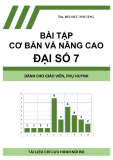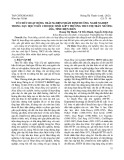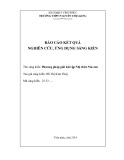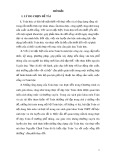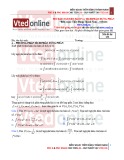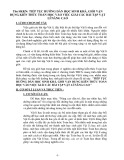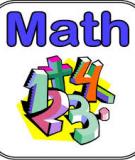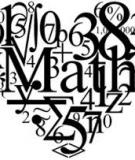Hurwitz Equivalence in Tuples of Dihedral Groups, Dicyclic Groups, and Semidihedral Groups
Charmaine Sia Department of Mathematics Massachusetts Institute of Technology Cambridge, MA 02139-4307, USA sia@mit.edu
Submitted: Dec 27, 2008; Accepted: Jul 27, 2009; Published: Aug 7, 2009 Mathematics Subject Classification: 20F36, 20F05
Abstract
2m , and M n
4M , SDn
Let D2N be the dihedral group of order 2N , Dic4M the dicyclic group of or- der 4M , SD2m the semidihedral group of order 2m, and M2m the group of order 2m = β2 = 1, βαβ−1 = α2m−2+1i. We classify with presentation M2m = hα, β | α2m−1 2N , Dicn the orbits in Dn 2m under the Hurwitz action.
1 Introduction
Let Bn denote the braid group on n strands, which is given by the presentation
Bn = hσ1, . . . , σn−1 | σiσj = σjσi, |i − j| > 2; σiσi+1σi = σi+1σiσi+1, 1 6 i 6 n − 2i.
For an arbitrary group G and n > 2, there is an action of Bn on Gn, called the Hurwitz action, which is defined by
i+1aiai+1, ai+2, . . . , an)
σi(a1, . . . , an) = (a1, . . . , ai−1, ai+1, a−1
for every 1 6 i 6 n − 1 and (a1, . . . , an) ∈ Gn. Note that
i (a1, . . . , an) = (a1, . . . , ai−1, aiai+1a−1 σ−1
i
i
, ai, ai+2, . . . , an).
Hence, if we write a = (a1, . . . , an) ∈ Gn and define π(a) = a1 · · · an ∈ G, then π(a) is an invariant of the Hurwitz action on Gn. An action by σi or σ−1 on Gn is called a Hurwitz move. Two tuples (a1, . . . , an), (b1, . . . , bn) ∈ Gn are said to be (Hurwitz) equivalent, denoted (a1, . . . , an) ∼ (b1, . . . , bn), if they lie in the same Bn-orbit.
the electronic journal of combinatorics 16 (2009), #R95
1
The problem of classifying the orbits in Gn under the Hurwitz action arose from the study of braid monodromy factorization (see, e.g., Kulikov and Teicher [5]). Clearly, this
2m and Dn
problem is trivial for any abelian group G: two n-tuples a, b ∈ Gn are equivalent if and only if one is a permutation of the other. However, there are few results on the classification of Bn-orbits in Gn for nonabelian groups G. Ben-Itzhak and Teicher [1] determined all Bn-orbits in Sn m represented by (t1, . . . , tn), where Sm is the symmetric group of order m!, each ti is a transposition, and t1 · · · tn = 1. Recently, Hou [3] determined completely the Bn-orbits in Qn 2pm, where Q2m is the generalized quaternion group of order 2m and D2pm is the dihedral group of order 2pm for some prime p. Clearly, if it of (a1, . . . , an) in Gn is a1, . . . , an ∈ G generate a finite subgroup, then the Bn-orb! finite. Humphries [4] and Michel [6] proved a partial converse when G is the general linear group GL(Rn): if s1, . . . , sn ∈ GL(Rn) are reflections such that the Bn-orbit of (s1, . . . , sn) is finite, then the group generated by s1, . . . , sn is finite.
2N . In Section 3, we classify the orbits in Dn
In this paper, we determine completely the Bn-orbits in Gn for four families of groups G: the dihedral group D2N of order 2N, the dicyclic group Dic4M of order 4M, the semidi- hedral group SD2m of order 2m, and the group M2m = hα, β | α2m−1 = β2 = 1, βαβ−1 = α2m−2+1i of order 2m. Our method is to find a number of invariants of the Hurwitz action and show that these invariants completely determine the Hurwitz equivalence classes. The invariants and the strategies used to find a canonical representative equivalent to each tuple are essentially the same as those in [3]. The novel element of the present paper is the idea that when performing a series of Hurwitz moves to normalize a tuple in Dn 2N with respect to a prime factor of N, we can preserve certain congruence properties with respect to other factors of N that were obtained in earlier moves.
2m.
2m, and M n
This paper is organized as follows. In Section 2, we develop some preliminary results 2N under 4M , regarding the Hurwitz action on Dn the Hurwitz action. In Section 4, we classify the Hurwitz equivalence classes in Dicn SDn
2 The Hurwitz Action on Dn 2N
In this section, we develop some preliminary results regarding the Hurwitz action on Dn 2N . With the exception of Lemma 2.1(iv), the results presented in this section are similar to those in [3, Section 2].
We use the following generators and relations for the dihedral group D2N of order 2N:
D2N = hα, β | αN = β2 = 1, βαβ−1 = α−1i. Each element of D2N can be uniquely written in the form αiβj, where 0 6 i < N and 0 6 j 6 1. Conjugating one element of D2N by another gives
(2.1)
(αkβl)−1(αiβj)(αkβl) = α(−1)l(i−2kj)βj, (αiβj)(αkβl)(αiβj)−1 = α(−1)j k+2ilβl. (2.2)
2N yields one of the following two equivalences:
Therefore, a Hurwitz move in Dn
the electronic journal of combinatorics 16 (2009), #R95
2
(· · · , αiβj, αkβl, · · · ) ∼ (· · · , αkβl, α(−1)l(i−2kj)βj, · · · ), (· · · , αiβj, αkβl, · · · ) ∼ (· · · , α(−1)j k+2ilβl, αiβj, · · · ).
To direct the reader’s attention to the Hurwitz moves that we consider, we shall occa- sionally omit common terms from two equivalent n-tuples a, b ∈ Gn if there is a sequence of moves transforming a to b that does not involve any of those terms. For example, setting (j, l) = (0, 0), (0, 1), (1, 0), and (1, 1) respectively in the above equivalences and omitting common terms, we obtain
(αi, αk) ∼ (αk, αi), (2.3)
(2.4) (αi, αkβ) ∼ (αkβ, α−i), (αi, αkβ) ∼ (αk+2iβ, αi), (cid:26)
(2.5) (αiβ, αk) ∼ (αk, αi−2kβ), (αiβ, αk) ∼ (α−k, αiβ), (cid:26)
(2.6) (αiβ, αkβ) ∼ (αkβ, α−i+2kβ) = (αi+(k−i)β, αk+(k−i)β), (αiβ, αkβ) ∼ (α−k+2iβ, αiβ) = (αi−(k−i)β, αk−(k−i)β). (cid:26) The following lemma sets forth some key equivalences that can be obtained through a sequence of Hurwitz moves.
Lemma 2.1 (see Hou [3, Lemma 2.1]). (i) (αi, αjβ) ∼ (α−i, αj+2iβ) for all i, j ∈ Z.
(ii) (αiβ, αjβ) ∼ (αi+h(j−i)β, αj+h(j−i)β) for all h, i, j ∈ Z.
r ) and τ ∈ Z, we have
t r=1 pkr
r=1 pνr
r=1 pνr
r=1 pνr
(iii) Let p1, . . . , pt be distinct prime divisors of N (not necessarily all the prime divisors r kN for r = 1, . . . , t, and let 0 6 νr 6 kr − 1 for r = 1, . . . , t. Let of N) such that pkr e, f ∈ Z such that e 6≡ f (mod pr) for r = 1, . . . , t. Then for all g ∈ Z such that g ≡ 0 (mod N/
r β, ατ +(f +g) Qt
r β, ατ +f Qt
r β).
r β) ∼ (ατ +(e+g) Qt
Q r=1 pνr (ατ +e Qt
r=1 pνr
r=1 pνr
r=1 pνr
r=1 pνr
r β, ατ +f Qt
r β, ατ +(f +g) Qt
r β) ∼ (ατ +(e+g) Qt
r β),
(iv) Let p1, . . . , pt be distinct prime divisors of N (not necessarily all the prime divisors r kN for r = 1, . . . , t, and let 0 6 νr 6 kr − 1 for r = 1, . . . , t. of N) such that pkr Then for all e 6≡ f (mod pr), there exists g ∈ Z such that
| f + g, and
r′
r , and if pr′ is another prime divisor of N such
). (a) (ατ +e Qt (b) pkr−νr r (c) if pr′ is another prime divisor of N, then f + g ≡ f (mod pkr′ −νr′
t r=1 pνr | (f + g)
t r=1 pνr r .
r , then pkr′ r′ Q
| f In particular, pkr | (f + g) that pkr′ t r=1 pνr r′
Q Q Proof. (i) We have
(αi, αjβ) ∼ (αjβ, α−i) (using the first equivalence in (2.4))
the electronic journal of combinatorics 16 (2009), #R95
3
∼ (α−i, αj+2iβ) (using the first equivalence in (2.5)).
(ii) This follows from (2.6).
t r=1 pνr
(iii) Setting i = τ + e
r and j = τ + f t r=1 pνr r ≡ g
t r=1 pνr r t r=1 pνr
in (ii), we see that it suffices to r (mod N). This can be achieved Q find h ∈ Z satisfying h(f − e) by using the Chinese Remainder Theorem to choose h such that Q Q Q
h ≡ g(f − e)−1 (mod pkr−νr
r (mod N/
r ).
h ≡ 0 ) for r = 1, . . . , t, t r=1 pkr
r and j = τ + f
t r=1 pνr
t
t
(iv) Setting i = τ + e in (ii), we see that it suffices to Q t r=1 pνr r find g, h ∈ Z satisfying the following system of congruences: Q Q
i=1 Y
i=1 Y
h(f − e) (mod N), pνr r ≡ g pνr r
g ≡ −f
g ≡ 0 ) for all other primes pr′ dividing N. (mod pkr−νr ), r (mod pkr′ −νr′ r′
This can be achieved by using the Chinese Remainder Theorem to choose h such that
h ≡ −f (f − e)−1
h ≡ 0 ) for all other primes pr′ dividing N. (mod pkr−νr ), r (mod pkr′ −νr′ r′
r that satisfies the conditions in (iv). This proves the lemma.
t i=1 pνr
It is easy to see that corresponding to any choice of h, there is a unique value of g modulo N/
Q
3 Bn-orbits in Tuples of Dihedral Groups
2N , where 0 6 ik < N and 0 6 jk 6 1, let
In this section, we classify the orbits in Dn 2N under the Hurwitz action. The main idea behind our proof is as follows. First, we partition Dn 2N into subsets, each of which is invariant under the Hurwitz action. We then find a number of invariants of the Hurwitz action and show that these invariants completely determine the equivalence classes within each subset. For a = (αi1βj1, . . . , αinβjn) ∈ Dn
Λ(a) = the multiset {min{ik, N − ik} : jk = 0}
and
Γ(a) = {ik : jk = 1}.
the electronic journal of combinatorics 16 (2009), #R95
4
For example, if a = (α12, α11β, α4, α3) ∈ D4 30, then Λ(a) = {3, 4, 3} and Γ(a) = {11}. It is easy to see that Λ(a) is invariant under each of the Hurwitz moves in (2.3)–(2.6), hence it is an invariant of the Hurwitz action.
1 · · · pkm
2N : Γ(a) = ∅}.
We fix a notational convention here. If N is odd, we write its prime factorization as m ; if N is even, we write its prime factorization as N = 2k0pk1 m (i.e., 2N into N = pk1 1 · · · pkm we set p0 = 2). Let vpr(i) denote the pr-adic order of a number i. We partition Dn subsets as follows. Let
r , let
A = {a ∈ Dn For each odd prime divisor pr of N, for each 0 6 νr 6 kr and 0 6 τr < pνr
2N : min({vpr(i) : i ∈ Λ(a)} ∪ {kr}) = νr, ∅ 6= Γ(a) ⊂ τr + pνr
r
νr,τr = {a ∈ Dn Bpr
Z} ,
r , let
and for each 0 6 νr 6 kr − 1 and 0 6 τr < pνr
2N : min({vpr(i) : i ∈ Λ(a)} ∪ {kr}) > νr + 1, ∅ 6= Γ(a) ⊂ τr + pνr
r
νr,τr = {a ∈ Dn Cpr
Z,
∃j, j′ ∈ Γ(a) such that vpr (j − j′) = νr} .
Then, for any odd prime divisor pr of N, we have
2N = A ⊔
νr,τr
. Bpr Dn (3.1) ⊔ Cpr νr,τr
G06νr6kr−1
06τr It is easy to check that each of A, Bpr
νr,τr , and Cpr
in (2.3)–(2.6). Thus A, Bpr
νr,τr , and Cpr
νr,τr is invariant under the Hurwitz moves
νr,τr are invariant under the Hurwitz action. For a ∈ Cpr νr,τr, collect the components of a of the form αiβ from left to right and let
the result be (αi1β, . . . , αitβ), where 0 6 ik < N. Let es ∈ Zpr , 1 6 s 6 t, be defined by
is ≡ τr + pνr r es (mod pνr+1 r t ). Define s=1
X (−1)s−1es. σpr (a) = For example, let N = 135 = 33 · 5, pr = 3, νr = 2, τr = 3, n = 4, and let 2,7. a = (α7+32·13β, α32·6, α7+32·2β, α7+32·11β) ∈ C3 νr,τr,0 = {a ∈ Cpr
Cpr νr,τr : σpr (a) = 0} Then σ3(a) = 13 − 2 + 11 = 1 ∈ Z3. It is easy to see from (2.3)–(2.6) that σ(a) is also
an invariant under the Hurwitz equivalence. This allows us to further partition Cpr
νr,τr into
two invariant subsets νr,τr,1 = {a ∈ Cpr
Cpr νr,τr : σpr (a) 6= 0}. and Thus, the partition (3.1) can be further refined into 2N = A ⊔ νr,τr Dn Bpr (3.2) ⊔ ⊔ Cpr
νr,τr,0 Cpr
νr,τr,1 the electronic journal of combinatorics 16 (2009), #R95 5 G06νr6kr−1
06τ ν0,τ0 = {a ∈ Dn
B2 2N : min({v2(i) : i ∈ Λ(a)} ∪ {k0 − 1}) = ν0, ∅ 6= Γ(a) ⊂ τ0 + 2ν0Z} , for odd primes pr dividing N. If N is even, we require some additional definitions. For each 0 6 ν0 6 k0 and 0 6 τ0 < 2ν0, let ν0,τ0 = {a ∈ Dn
C2 2N : min({v2(i) : i ∈ Λ(a)} ∪ {k0 − 1}) > ν0 + 1, ∅ 6= Γ(a) ⊂ τ0 + 2ν0Z and for each 0 6 ν0 6 k0 − 1 and 0 6 τ0 < 2ν0, let ∃j, j′ ∈ Γ(a) such that v2(j − j′) = ν0} . ν0,τ0, and C2 ν0,τ0 are all invariant under the Hurwitz equivalence and Then A, B2 2N = A ⊔ ν0,τ0 Dn B2 . (3.3) ⊔ C2
ν0,τ0 G06ν06k0
06τ0<2ν0 G06ν06k0−1
06τ0<2ν0
For a = (αi1βj1, . . . , αinβjn) ∈ C2
ν0,τ0, where 0 6 ik 6 N and 0 6 jk 6 1, let u(a) = #{k : jk = 1 and ik ≡ τ0 + 2ν0 (mod 2ν0+1)}. It is easy to check that u(a) is also invariant under the Hurwitz action. Having set up this framework, we are now ready to define our desired partition P of
Dn
2N . Let Q be the common refinement of the partitions (3.2) as pr varies over all the odd
prime factors of N. If N is odd, then we take P = Q, so that any block of the partition
P is either A or has the form ν2,τ2 ∩ · · · ∩ X pm ν1,τ1 ∩ X p2 νm,τm, νr,τr stands for one of Bpr νr,τr,0, or Cpr νr,τr , Cpr X p1 where each X pr
νr,τr,1. If N is even, we take P to be
the common refinement of Q and (3.3). Let R ⊔ S0 ⊔ S1 ⊔ T ⊔ U be a partition of the set
of prime divisors of N, with the restriction that 2 6∈ R ∪ S0 ∪ S1, and either T = U = ∅,
(T, U) = ({2}, ∅), or (T, U) = (∅, {2}). For convenience, we will denote the block νr,τr νr,τr pr∈R
\ pr∈S0
\ pr∈S1
\ pr∈T
\ pr∈U
\ Bpr ∩ ∩ ∩ Bpr ∩ Cpr
νr,τr,0 Cpr
νr,τr,1 Cpr
νr,τr ! ! ! ! ! 1,1 ∩ C3 2,8,0 ∩ B5 1,4 ∩ B7 1,0. by Π(R, S0, S1, T, U)(νr)(τr), where (νr) and (τr) represent vectors that record the num-
bers νr and τr for each prime pr. For example, if p0 = 2, p1 = 3, p2 = 5, and p3 = 7,
then Π({5, 7}, {3}, ∅, ∅, {2})(1, 2, 1, 1)(1, 8, 4, 0) = C2 the electronic journal of combinatorics 16 (2009), #R95 6 By our remarks above, each block of P is invariant under the Hurwitz action, hence it
suffices to find a set of representatives of the Bn-orbits in A and in each of the blocks
Π(R, S0, S1, T, U)(νr)(τr). This is achieved in Theorem 3.1 below. Theorem 3.1. (i) The Bn-orbits in A are represented by (αi1, . . . , αin), where 0 6 i1 6 · · · 6 in < N. i ; if N is even,
further let 1 6 ν0 6 k0 and 0 6 τ0 < 2ν0. The Bn-orbits in Π(R, S0, S1, T, U)(νr)(τr)
are represented by w (ii) For each odd prime divisor pr of N, let 0 6 νr 6 kr and 0 6 τi < pνi n−s−1 ), (3.4) (αi1, . . . , αis, ατ +Eβ, ατ +F β, }| { ατ +Gβ, . . . , ατ +Gβ, ατ β, . . . , ατ β
z where {z } | r and τ ≡ τr (mod pνr r ) for pr|N pνr (a) 0 6 s < n and 0 6 i1 6 · · · 6 is 6 N/2,
(b) τ is the unique integer such that 0 6 τ < each prime pr dividing N, Q (c) for each pr ∈ R, we have min{vpr(i1), . . . , vpr(is), kr} = νr, n − s − 1 > 0, | G, pνr
r | E, pkr
r | F , and pkr
r r r ), and pkr
r (d) for each pr ∈ S0, we have min{vpr(i1), . . . , vpr(is), kr} > νr + 1, n − s − 1 > 2, (mod pνr+1 (mod pkr | G, E ≡ pνr
r ), F ≡ pνr
r r kE, pkr
pνr
r (e) for each pr ∈ S1, we have min{vpr(i1), . . . , vpr(is), kr} > νr + 1, n − s − 1 > 1, | G, | F , and pkr
r (f ) if 2 ∈ T , then min{v2(i1), . . . , v2(is), k0 − 1} = ν0 − 1, n − s − 1 > 0, 2ν0 | E, 2k0 | F , and 2k0 | G, (g) if 2 ∈ U, then min{v2(i1), . . . , v2(is), k0 − 1} > ν0, 2ν0kE, G ≡ 2ν0 (mod 2k0), and either
(1) 2k0 | F and w = 0 (so u(a) = 1) or
(2) F ≡ 2ν0 (mod 2k0) and n − s − 1 > w + 2 (so u(a) > 2). There are certain degenerate cases where terms of the form ατ +F or ατ +G do not ap-
pear in (3.4); this occurs exactly when conditions (c)–(g) force F ≡ G ≡ 0 (mod N). The reason for our final comment is that a term of the form ατ +F arises only when ki ki
i S0 ∪ U is nonempty, while terms of the form ατ +G arise only when U is nonempty. ki
i i i ∼= D2p
be the canonical projection. We remark that
, ϑ(a) = (ϕ(a1), . . . , ϕ(an)), the images of the representa-
tives in (3.4) agree with the representatives in [3, Theorems 3.1 and 4.2] up to the ordering
of αi1, . . . , αis. Thus Theorem 3.1 can be viewed as a generalization of the results in [3].
Before proceeding with the proof of Theorem 3.1, we give two examples to familiarize
the reader with the content of parts (ii)(b)–(g). Suppose N = 225 = 32 ·52, p1 = 3, p2 = 5, the electronic journal of combinatorics 16 (2009), #R95 7 under the map ϑ : Dn Let ϕ : D2N → D2N /hαN/p
2N → Dn
2p n = 2, and consider the block Π({3, 5}, ∅, ∅, ∅, ∅)(1, 1)(2, 3). Since S0 = S1 = T = U = ∅,
only the conditions in parts (a)–(c) apply; furthermore, there are no terms of the form
ατ +F or ατ +G. From (ii)(b), we have 0 6 τ < 15, τ ≡ 2 (mod 3), and τ ≡ 3 (mod 5), so
τ = 8. From (ii)(c), min{v3(i1), . . . , v3(is), 2} = 1 and min{v5(i1), . . . , v5(is), 2} = 1, so
we must have s = 1 and v3(is) = v5(is) = 1; also, 3 | E and 5 | E, so 15 | E. Finally,
from (ii)(a), 0 6 i1 6 225/2. Thus, by (3.4), the equivalence classes in this block are
represented by (α15i, α8+15eβ), where gcd(15, i) = 1, 1 6 i 6 15/2, and e ∈ Z. Now, suppose instead that N = 36 = 22 · 32, p0 = 2, p1 = 3, n = 2, and consider the
block Π({3}, ∅, ∅, ∅, {2})(1, 2)(0, 7). From (ii)(b), we have 0 6 τ < 18, τ ≡ 0 (mod 2),
and τ ≡ 7 (mod 9), so τ = 16. From (ii)(g), we have 2kE. Now, (ii)(g)(2) would require
that n > 3, so we only need to consider (ii)(g)(1); this condition implies that there are
no terms of the form ατ +F or ατ +G. Moreover, since 2 ∈ U, both terms must be of the
form αiβ. Finally, from (ii)(c), we have 32 | E, so E ≡ 18 (mod 36). Thus, the (unique)
equivalence class in this block is represented by (α34β, α16β). Proof of Theorem 3.1. (i) This is clear. s+1β, . . . , αi′ 1, . . . , αi′ s, αi′ nβ). (ii) First, we observe that different tuples in (3.4) have different combinations of invari-
ants Λ(a), π(a), σpr(a), and u(a) (whenever these invariants are defined for a).
Thus, different tuples in (3.4) are inequivalent.
Next, we show that every a ∈ Π(R, S0, S1, T, U)(νr)(τr) is equivalent to one of the
tuples in (3.4). Since we can use a sequence of Hurwitz moves to shift all the terms
of the form αi to the front, we may as well assume that a has the form a = (αi′ 1, . . . , αi′ s, ατ +e1 Qpr |N pνr r β, . . . , ατ +et Qpr |N pνr The general idea behind our proof is to write a in the form r β) r a = (αi′ r pr|N pνr pνr
r to mean Q Q the electronic journal of combinatorics 16 (2009), #R95 8 and consider the effects of Hurwitz moves on the numbers e1, . . . , et modulo pkr−νr
for each prime pr dividing N. To avoid cluttering up expressions, we shall use the
notation
in the sequel; if a different product is intended, it
will be specified in the subscript of the product symbol. Note that the existence and
uniqueness of τ is a direct consequence of the Chinese Remainder Theorem. Because
the case pr = 2 must be handled differently from the case of odd pr, we shall first
prove the theorem for odd values of N, and then show how the proof can be modified
to work for even values of N. Observe that it suffices to prove that we can obtain the
conditions in parts (c)–(g), since we can then use (2.3) and Lemma 2.1(i) repeatedly
to ensure that part (a) is also satisfied. 1, . . . , αi′ s, ατ +e1 Q pνr r β, ατ +e2 Q pνr First suppose that N is odd, so that we only need to prove that we can obtain the
conditions in parts (c)–(e). We proceed by induction on t, the number of terms of
the form αiβ in a. The case t = 1 is trivial. Suppose t = 2. Write a in the form r β). νr,τr,0, we cannot have a ∈ Cpr 1), . . . , vpr(i′ k to the right until the last three terms of a are a = (αi′ k, ατ +e1 Q pνr r β, ατ +e2 Q pνr Note that by the definition of Cpr
νr,τr,0 for any prime
divisor pr of N (because t = 2). Hence, we must have e1 6≡ e2 (mod pr) for every
νr,τr , either Λ(a) 6= ∅
prime pr ∈ S0 ∪S1. Suppose that pr ∈ R. By the definition of Bpr
k), is equal to νr, or Λ(a) = ∅. First
and at least one of vpr(i′
s), say vpr (i′
suppose that we are in the former case. Applying (2.3) and (2.4) multiple times, we
can shift the term αi′ r β). (αi′ 1 Q pνr r β, ατ +e2 Q pνr k, ατ +e′ r β), If e1 ≡ e2 (mod pr), then applying Lemma 2.1(i) to the first two terms yields 1 6≡ e2 (mod pr). Thus we may assume that e1 6≡ e2 (mod pr) for all prime (α−i′ Q pνr r r β, ατ +f2pkr −νr r β, ατ +e2 Q pνr r β) where e′
divisors pr of N. Now, by Lemma 2.1(iv), we have r β) ∼ (ατ +f1 Q pνr r′ (3.5) (ατ +e1 Q pνr r β, ατ +e2 Q pνr r β) ∼ (ατ +Eβ, ατ β). for some f2 such that if pr′ is another prime divisor of N such that pkr′ −νr′
| e2, then
pkr′ −νr′
| f2 also. If Λ(a) = ∅ instead, then νr = kr by definition of Bpr
νr,τr and we
r′
obtain (3.5) without any additional work. Repeating this argument for each prime
pr dividing N, we have (ατ +e1 Q pνr 1, . . . , αi′ s, ατ +e1 Q pνr r β, . . . , ατ +et Q pνr This completes the case t = 2.
Now assume t > 2. Again, we write a in the form r β). a = (αi′ r β, . . . , ατ +ft−1 Q pνr r β, ατ +ft Q pνr First consider pr ∈ R. As before, we wish to apply a sequence of Hurwitz moves to
obtain an n-tuple r β) ∼ a a′ = (αj1, . . . , αjs, ατ +f1 Q pνr r′ r′ | et, then pkr′ −νr′ Q pνr r r β, ατ +ftpkr −νr r β, ατ +et Q pνr r β) r β) ∼ (ατ +ft−1 Q pνr such that if pr′ is another prime divisor of N such that pkr′ −νr′
| ft
also. Using a similar argument as above, we may assume that et−1 6≡ et (mod pr) for
every pr ∈ R, and hence by Lemma 2.1(iv), we have the electronic journal of combinatorics 16 (2009), #R95 9 (ατ +et−1 Q pνr r′ | et, then 1, . . . , αi′ s, ατ +e1 Q pνr for some ft such that if pr′ is another prime divisor of N such that pkr′ −νr′
pkr′ −νr′
| ft also. Repeating this argument for each prime pr ∈ R, we have
r′ r β)
r g1β, . . . , ατ +gt−1 Q pνr r β, ατ +gt Q pνr r β, . . . , ατ +et Q pνr
∼ (αj1, . . . , αjs, ατ +g1 Q pνr r β), a = (αi′ r where pkr−νr | gt for every prime pr ∈ R. r β) Now consider pr ∈ S0 ∪ S1. Assume that gl 6≡ gl+1 ≡ · · · ≡ gt (mod pr). By (2.6)
and Lemma 2.1(iv), we have r β, ατ +gl+1 Q pνr
r β, ατ +gl Q pνr r β, . . . , ατ +gt Q pνr r β, . . . , ατ +gt Q pνr
r β) l Q pνr t−2 Q pνr r β, ατ +gt Q pνr l Q pνr t−2 Q pνr r β)
r β, ατ +ht Q pkr r β, ατ +gl Q pνr
r β, ατ +ht−1 Q pνr r β, . . . , ατ +g′
r β, . . . , ατ +g′ r β), (ατ +gl Q pνr
l Q pνr ∼ (ατ +g′
∼ · · ·
∼ (ατ +g′
∼ (ατ +g′ r′ | gt, then 1, . . . , αi′ s, ατ +e1 Q pνr r β) | ht also. Repeating this argument for each prime pr ∈ S0 ∪ S1, we obtain for some ht such that if pr′ is another prime divisor of N such that pkr′ −νr′
pkr′ −νr′
r′ r β, . . . , ατ +ht−1 Q pνr r , ατ β) = b. r β, . . . , ατ +et Q pνr
∼ (αj1, . . . , αjs, ατ +h1 Q pνr r β, . . . , ατ +ht−1pνr a = (αi′ If h1, . . . , ht−1 are not all the same modulo pr for any prime divisor pr of N, then
the induction hypothesis applies to b = (αj1, . . . , αjs, ατ +h1pνr
r , ατ β).
So assume that the set I of prime divisors pr of N such that h1 ≡ · · · ≡ ht−1 6≡
0 (mod pr) is nonempty. Let J be the set of prime divisors of N that are not in I.
By the Chinese Remainder Theorem, we can find an integer M satisfying the system
of congruences M ≡ 0 for each ps ∈ J, M p ≡ 1 for each pr ∈ I. (mod pks
s )
(mod pkr
r ) t−1 Qr∈I pνr 1 Qr∈I pνr r β, . . . , ατ +h′ t−1 (mod pr) for each pr ∈ I and x ≡ 0 (mod pks r , ατ β). Let x ∈ Z be such
s ) for each ps ∈ J. Yp∈I
p6=pr r β, ατ β) t−1 Qpr ∈I pνr
t−1+M ) Qpr ∈I pνr r β, ατ +h′
r β, ατ +(h′ r β, ατ +M Qpr ∈I pνr r β) Write b as (αj1, . . . , αjs, ατ +h′
that x 6≡ −h′
Then, using Lemma 2.1(iii) repeatedly, we have r β, ατ +M Qpr ∈I pνr r β) t−1+x+M ) Qpr ∈I pνr
t−1+x) Qpr ∈I pνr t−2 Qpr ∈I pνr
t−2 Qpr ∈I pνr
t−2+x) Qpr ∈I pνr
t−2+x) Qpr ∈I pνr r β, ατ +(h′
r β, ατ +(h′ r β, ατ β). (3.6) the electronic journal of combinatorics 16 (2009), #R95 10 (ατ +h′
∼ (ατ +h′
∼ (ατ +(h′
∼ (ατ +(h′ r′ If t = 3, use the Chinese Remainder Theorem to choose x such that t−1 + x) r pr′ ∈I pνr′
pνr
r (h′ ≡ 1 (mod pkr−νr ) ! Q t−1, 0 (mod pr) for each pr ∈ I. Then the (mod pkr 1 Qpr ∈I pνr 1, . . . , αi′ s, ατ +h′ for each pr ∈ I and x ≡ 0 (mod pks
s ) for each ps ∈ J. Then the middle term becomes
ατ +F ′, where F ′ ≡ pνr
r ) for each pr ∈ I. Since S0 ⊆ I in this case because
r
h1 − h2 ≡ 0 (mod pr) for each pr ∈ I, condition (d) holds. Applying (3.5) to the first
two terms in (3.6) for each prime pr ∈ R ∪ S1, we can also get conditions (c) and (e)
to hold. Hence a is equivalent to the tuple in (3.4).
If t > 3, choose x such that x 6≡ −h′
induction hypothesis applies to t−1+x) Qpr ∈I pνr t−3 Qpr ∈I pνr
r β,
t−2+x) Qpr ∈I pνr r β, ατ +(h′ r β, . . . , ατ +h′
ατ +(h′ r β, ατ β). (αi′ This concludes the induction and completes the proof in the case that N is odd. ν0,τ0. If
ν0,τ0 for some ν0 and τ0, then the technique for primes pr ∈ R carries over
In what follows, we concentrate on the case Now, we describe how the proof above can be modified to work for even N.
a ∈ B2
almost exactly to the case pr = 2.
a ∈ C2 r β, ατ β, . . . , ατ β r β, ατ +f2 Q pνr r f1β, ατ +e1 Q pνr First observe that the proof for odd N can be carried out in steps: we change terms
in the n-tuple to ατ β one-by-one, starting from the rightmost element and working
our way left until we reach the third element of the form αiβ from the left. We shall
use a similar approach when N is even, except that we wish to obtain one of the
following two tuples after changing all but the first three elements of the form αiβ: t−3 ), if u(a) = 1, (ατ +f1 Q pνr r β, ατ −gβ, . . . , ατ −gβ r β, ατ +f1 Q pνr r β, ατ +e2 Q pνr t−u−1 , ατ β, . . . , ατ β (ατ +e1 Q pνr ), | } {z
u−2 | {z if u(a) > 2,
} {z } | (3.7)
where e1 and e2 are odd, f1 and f2 are even, and g satisfies the congruences r β, where y has different parity from z, occurring before ατ +z Q pνr (3.8) g ≡ 0
g ≡ 2ν0 (mod N/2k0),
(mod 2k0). the electronic journal of combinatorics 16 (2009), #R95 11 This can be achieved as follows. Consider the first term from the right that does
not agree with the form mentioned above; let it be ατ +z Q pνr
r β. Observe that by the
definition of u(a) and the form of the n-tuples in (3.7), there exists a term of the
form ατ +y Q pνr
r β. r β to the right until we r β, ατ +z Q pνr r β). Using the second equivalence in (2.6), we can shift ατ +y Q pνr
have an adjacent pair (ατ +y Q pνr r β, ατ +z′ Q pνr Now, using Lemma 2.1(iii), we can find an equivalent pair r β), (ατ +y′ Q pνr r ≡ −2ν0 or 0 (mod 2k0) as desired. We can then use Lemma 2.1(iv)
where z′
pνr
again for all the odd primes pr, as in the case where N is odd, so that the term that
was previously ατ +z Q pνr
r β now has the correct form. Finally, by performing Hurwitz
moves on the 3 leftmost terms, we can ensure that e1, e2, f1, and f2 have the correct
parity.
At this stage, consider the first three terms of the form αiβ in the resulting n-tuple.
If u(a) = 1, we want to show that r β, ατ +f2 Q pνr r β, ατ +e1 Q pνr r β) ∼ (ατ +E, ατ +F , ατ ), Q (ατ +f1 Q pνr r β, ατ +f1 Q pνr r β, ατ +e2 Q pνr r β) ∼ (ατ +E, ατ +F , ατ ). where E and F satisfy the conditions in Theorem 3.1; if u(a) > 2, we want to show
that (ατ +e1 Q pνr First suppose u(a) = 1. Using the same technique as above, we can obtain r β, ατ +f2 Q pνr r β, ατ +e1 Q pνr r β) ∼ (ατ +f ′ β, ατ +e′ β, ατ β), (3.9) (ατ +f1 Q pνr r (mod pνr+1 r (mod pkr r r β, ατ +f1 Q pνr r β, ατ +e2 Q pνr ), f ′ ≡ pνr r β, ατ +f1 Q pνr r β) where f ′ is even, e′ is odd, and e′ ≡ pνr
r ) for each pr ∈
S0. Applying (3.5) to the second tuple in (3.9) for every prime pr ∈ R ∪ S1 ∪ T ∪ U,
we see that a is equivalent to the tuple in (3.4).
Now suppose u(a) > 2. Notice that in (ατ +e1 Q pνr
r β), we
never have x ≡ y ≡ z (mod pr) for any pr (because x−y+z ≡ 0 (mod pr)). Therefore,
using Lemma 2.1(iv) repeatedly to adjust the middle term, we obtain r β, ατ +e2 Q pνr
r β, ατ −F β, ατ +f ′′ Q pνr
r β, ατ +f ′′′ Q pνr (3.10) r β)
r β, ατ −F β) r νr,τr,0, and Cpr (ατ +e1 Q pνr
∼ (ατ +e′′ Q pνr
∼ (ατ +e′′ Q pνr (using the first equivalence in (2.6)) r β, ατ +f ′′′ Q pνr r β) ∼ (ατ +Eβ, ατ β). where e′′ is odd, f ′′ and f ′′′ are even, and f ′′′ ≡ 0 (mod pkr−νr
) for every pr ∈ S0.
Now, we concentrate on the first two terms (ατ +e′′ Q pνr
r β, ατ +f ′′′ Q pνr
r β). Returning
νr,τr , Cpr
to the definitions of Bpr
νr,τr,1 (for odd pr), we see that we have
e′′ 6≡ f ′′′ (mod pr) for any prime pr dividing N. Therefore, we can use Lemma 2.1(iv)
repeatedly for every prime pr to obtain the electronic journal of combinatorics 16 (2009), #R95 12 (3.11) (ατ +e′′ Q pνr Combining (3.7), (3.10), and (3.11), we obtain a ∼ (ατ +Eβ, ατ β, ατ −F β, ατ −Gβ, . . . , ατ −Gβ, ατ β, . . . , ατ β). (3.12) Finally, applying (2.6) repeatedly to (ατ β, ατ −F β, ατ −Gβ, . . . , ατ −Gβ), we obtain (3.13) (ατ β, ατ −F β, ατ −Gβ, . . . , ατ −Gβ)
∼ (ατ +F β, ατ β, ατ −Gβ, . . . , ατ −Gβ)
∼ (ατ +F β, ατ +Gβ, ατ β, ατ −Gβ, . . . , ατ −Gβ)
∼ · · ·
∼ (ατ +F β, ατ +Gβ, . . . , ατ +Gβ, ατ β) Combining (3.12) and (3.13), we see that a is equivalent to an n-tuple of the
form (3.4), as desired. This concludes the proof of the theorem. The following corollary is a direct consequence of Theorem 3.1. (i) Two n-tuples a, b ∈ A are equivalent if and only if a is a permu- Corollary 3.2.
tation of b. (ii) Two n-tuples a, b ∈ Π(R, S0, S1, T, U)(νr)(τr) are equivalent if and only if Λ(a) =
Λ(b), π(a) = π(b), σp(a) = σp(b) for each odd prime p | N such that a, b ∈ Cp
ν,τ ,
and u(a) = u(b) if 2 | N. The results in the previous section can also be applied to classify the Bn-orbits in dicyclic
groups, which are closely related to dihedral groups. The similarity between dihedral
groups and dicyclic groups can be seen from the presentation of the dicyclic group Dic4M
of order 4M: 4M is identical to that on Dicn Dic4M = hα, β | α2M = 1, αM = β2, βαβ−1 = α−1i. 2m of order
2m. These two families of groups share the property that for every m > 4, the electronic journal of combinatorics 16 (2009), #R95 13 Analogous to elements of D2N , each element of Dic4M can be uniquely written in the form
αiβj, where 0 6 i < 2M and 0 6 j 6 1. It is easy to check that equations (2.1) and (2.2),
and hence (2.3)–(2.6), also hold for Dic4M . In these equations, the only difference between
D2N and Dic4M that affects the Hurwitz action is that the element α has order N in D2N ,
but order 2M in Dic4M . If N = 2M, then there is no difference. Therefore, under the
bijection D4M → Dic4M , αiβj 7→ αiβj for 0 6 i < 2M, 0 6 j 6 1, the Hurwitz action on
Dn
4M . It follows that all results in Section 3 continue to hold
with D4M replaced by Dic4M . Hou [3] determined the Bn-orbits in the generalized quaternion group Qn 2m and in Dn there exists a maximal cyclic subgroup of index 2. There are exactly two other families
of groups of order 2m that possess this property. Following Gorenstein [2], we call one of
these groups the semidihedral group and denote it by SD2m. It has the presentation = β2 = 1, βαβ−1 = α2m−2−1i. SD2m = hα, β | α2m−1 We denote the other group by M2m; it has the presentation = β2 = 1, βαβ−1 = α2m−2+1i. M2m = hα, β | α2m−1 2m and M n 2m. The proofs of our results In this section, we classify the Bn-orbits in SDn are very similar to those in [3] and in Section 3, hence we omit them. 2m, where 0 6 ik < 2m−1 and 0 6 jk 6 1, let The semidihedral group SD2m of order 2m is defined for any m > 3. When m = 3, SD8
is isomorphic to the abelian group Z2 × Z4, so the problem of determining the Bn-orbits
in SD8 is trivial. In what follows, we concentrate on the case m > 4. Like the dihedral
group and the dicyclic group, every element of SD2m can be uniquely written in the form
αiβj, where 0 6 i < 2m−1 and 0 6 j 6 1.
For a = (αi1βj1, . . . , αinβjn) ∈ SDn λ(a) = the multiset min{ik, (2m−2 − 1)ik mod 2m−1} : jk = 0 (cid:9) and (cid:8)
γ(a) = {ik : jk = 1}. 2m : γ(a) = ∅}. Let A = {a ∈ SDn
For each 1 6 ν 6 m − 1 and 0 6 τ < 2ν, let 2m : min({v2(i) : i ∈ λ(a)} ∪ {m − 2}) = ν − 1, ∅ 6= γ(a) ⊂ τ + 2νZ} , Bν,τ = {a ∈ SDn where v2(i) is the 2-adic order of i. For each 0 6 ν 6 m − 2 and 0 6 τ < 2ν, let 2m : min({v2(i) : i ∈ λ(a)} ∪ {m − 2}) > ν, γ(a) ⊂ τ + 2νZ, Cν,τ = {a ∈ SDn ∃j, j′ ∈ Γ(a) such that v2(j − j′) = ν} . Then 16ν6m−1
G
06τ <2ν 06ν6m−2
G
06τ <2ν 2m = A ⊔
SDn . ⊔ Bν,τ
Cν,τ
the electronic journal of combinatorics 16 (2009), #R95 14 As in Section 3, it is easy to see that each of A, Bν,τ , and Cν,τ is invariant under the
Hurwitz action, so that it suffices to find a set of representatives of the Bn-orbits in each
of A, Bν,τ , and Cν,τ . For a = (αi1βj1, . . . , αinβjn) ∈ Cν,τ , where 0 6 ik < 2m−1 and 0 6 jk 6 1, let u(a) = #{k : jk = 1 and ik ≡ τ (mod 2v+1)}. Again, it is easy to see that u(a) is an invariant of the Hurwitz action. 2m. The following theorem classifies the Bn-orbits in SDn Theorem 4.1. Let m > 4, and let the semidihedral group SD2m be partitioned into sets
A, Bν,τ , and Cν,τ as above. (i) The Bn-orbits in A are represented by (αi1, . . . , αin), where 0 6 i1 6 · · · 6 in < 2m−1. (ii) Let 1 6 ν 6 m − 1 and 0 6 τ < 2ν. The Bn-orbits in Bν,τ are represented by (4.1) (αi1, . . . , αis, ατ +2ν eβ, ατ β, . . . , ατ β), where 0 6 i1 6 · · · 6 is < 2m−1, ik ∈ {min{i, (2m−2 − 1)i mod 2m−1} : 0 6 i 6
2m−1}, min{ν2(i1), . . . , ν2(is), m − 2} = ν − 1, and 0 6 e < 2m−1−ν. (iii) Let 1 6 ν 6 m − 2 and 0 6 τ < 2ν. The Bn-orbits in Cν,τ are represented by u β, . . . , ατ +2ν β, ατ β, . . . , ατ β (αi1, . . . , αis, ατ +2ν eβ, ατ +2ν ), (4.2) | {z } where 0 6 i1 6 · · · 6 is < 2m−1, ik ∈ {min{i, (2m−2 − 1)i mod 2m−1} : 0 6 i 6
2m−1}, min{ν2(i1), . . . , ν2(is), m − 2} > ν, 0 6 e < 2m−1−ν, e ≡ 1 (mod 2), and
u > 0. 2m to be equivalent. Analogous to Theorem 3.1, different n-tuples in (4.1) have different combinations of
invariants λ(a) and π(a), while different n-tuples in (4.2) have different combinations of
invariants λ(a), π(a), and u(a). This allows us to establish the following criterion for two
n-tuples in SDn Corollary 4.2. Let m > 4, and let the semidihedral group SD2m be partitioned into sets
A, Bν,τ , and Cν,τ as above. (i) Two n-tuples a, b ∈ A are equivalent if and only if a is a permutation of b. (ii) Two n-tuples a, b ∈ Bν,τ are equivalent if and only if λ(a) = λ(b) and π(a) = π(b). the electronic journal of combinatorics 16 (2009), #R95 15 (iii) Two n-tuples a, b ∈ Cν,τ are equivalent if and only if λ(a) = λ(b), u(a) = u(b), and π(a) = π(b). = β2 = 1, βαβ−1 = α2m−2+1i. M2m = hα, β | α2m−1 2m, let Like the dihedral group, the dicyclic group, and the semidihedral group, every element of
M2m can be uniquely written in the form αiβj, where 0 6 i < 2m−1 and 0 6 j 6 1. For a = (αi1βj1, . . . , αinβjn) ∈ M n k : jk = 0}, where i′ k = Φ(a) = the multiset{i′ ik,
ik mod 2m−2, if ik is even;
if ik is odd; (cid:26) k : jk = 1}, where i′′ and let Ψ(a) = the multiset{i′′ k = ik mod 2m−2.
2m. Then Φ(a) and Ψ(a) are invariants of the Hurwitz action on M n Let 2m : Ψ(a) = ∅}. 2m : Φ(a) ⊂ 2Z and Ψ(a) ⊂ τ + 2Z for τ = 0 or 1} ∪ {a ∈ M n D = {a ∈ M n Theorem 4.3. Let m > 3, and let the group M2m be partitioned into sets D and its
complement Dc as above. (i) The Bn-orbits in D are represented by (αi1, . . . , αis, αis+1β, . . . , αinβ), where 0 6 s 6 n, 0 6 i1 6 · · · 6 is < 2m−1, and 0 6 is+1 6 · · · 6 in < 2m−1, subject
to the conditions above. (ii) The Bn-orbits in Dc are represented by (4.3) (αi1, . . . , αir, αir+1, . . . , αis, αis+1β, . . . , αinβ), where 0 6 r 6 s < n, {i1, . . . , ir} ⊂ 2Z, {ir+1, . . . , is} ⊂ 1 + 2Z, 0 6 i1 6 · · · 6
ir < 2m−1, 0 6 ir+1 6 · · · 6 is < 2m−2, 0 6 is+1 6 · · · 6 in−1 6 2m−2, and
in−1 6 in < 2m−1. inequivalent. This yields the following criterion for two n-tuples in M n As before, the invariants Φ(a), Ψ(a) and π(a) show that distinct n-tuples in (4.3) are
2m to be equivalent.
Corollary 4.4. Let m > 3, and let the group M2m be partitioned into sets D and Dc as
above. (i) Two n-tuples a, b ∈ D are equivalent if and only if a is a permutation of b. the electronic journal of combinatorics 16 (2009), #R95 16 (ii) Two n-tuples a, b ∈ Dc are equivalent if and only if Φ(a) = Φ(b), Ψ(a) = Ψ(b) and π(a) = π(b). This research was carried out at the University of Minnesota Duluth under the supervision
of Joseph Gallian. Financial support was provided by the National Science Foundation
(grant number DMS 0754106), the National Security Agency (grant number H98230-06-
1-001), and the Massachusetts Institute of Technology Department of Mathematics. The
author would like to thank Joseph Gallian for his support and encouragement, as well as
Ricky Liu for his assistance in proofreading this paper. Finally, the author would like to
thank the referee for pointing out an error in Theorem 4.3 in a previous version of this
paper, and for several other useful comments and suggestions. [1] T. Ben-Itzhak and M. Teicher, Graph theoretic method for determining Hurwitz equiv- alence in the symmetric group, Israel J. Math. 135 (2003) 83–91. [2] D. Gorenstein, Finite Groups, 2nd ed., Chelsea Publishing Company, New York, 1980. [3] X. Hou, Hurwitz equivalence in tuples of generalized quaternion groups and dihedral groups, Electron. J. Combin. 15 (2008) #R80, 10pp. [4] S. P. Humphries, Finite Hurwitz braid group actions on sequences of Euclidean reflec- tions, J. Algebra 269 (2003) 556–558. [5] V. S. Kulikov, M. Teicher, Braid monodromy factorizations and diffeomorphism types, Izv. Math. 64 (2000) 311–341. the electronic journal of combinatorics 16 (2009), #R95 17 [6] J. Michel, Hurwitz action on tuples of Euclidean reflections, J. Algebra 295 (2006) 289–292.4 Bn-orbits in Tuples of Dicyclic and Semidihedral
Groups
4.1 Bn-orbits in SDn
2m
4.2 Bn-orbits in M n
2m
Let m > 3. Recall that M2m has the following representation in terms of generators and
relations:
Acknowledgments
References

